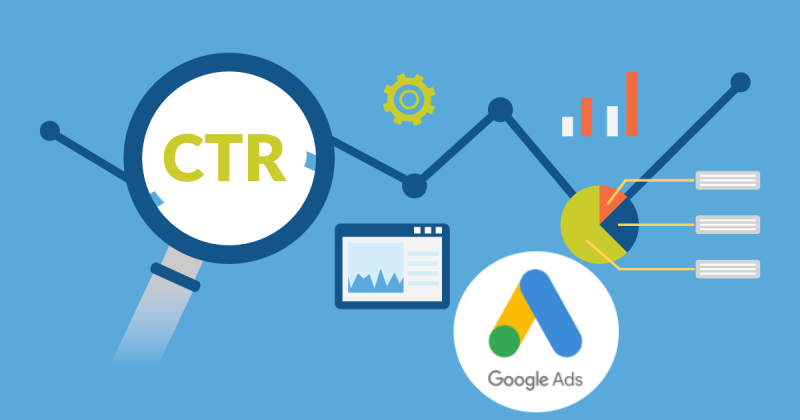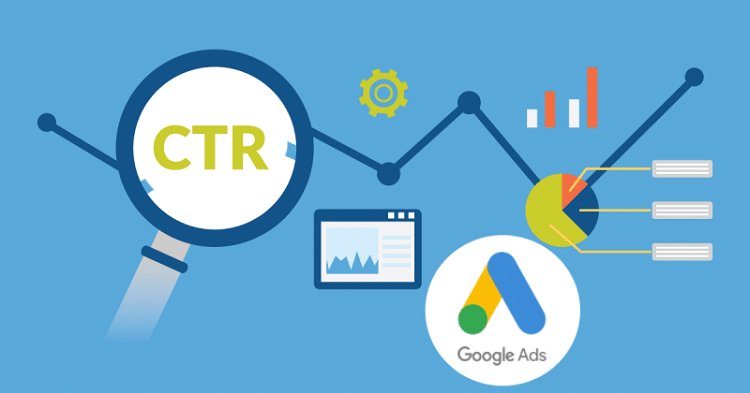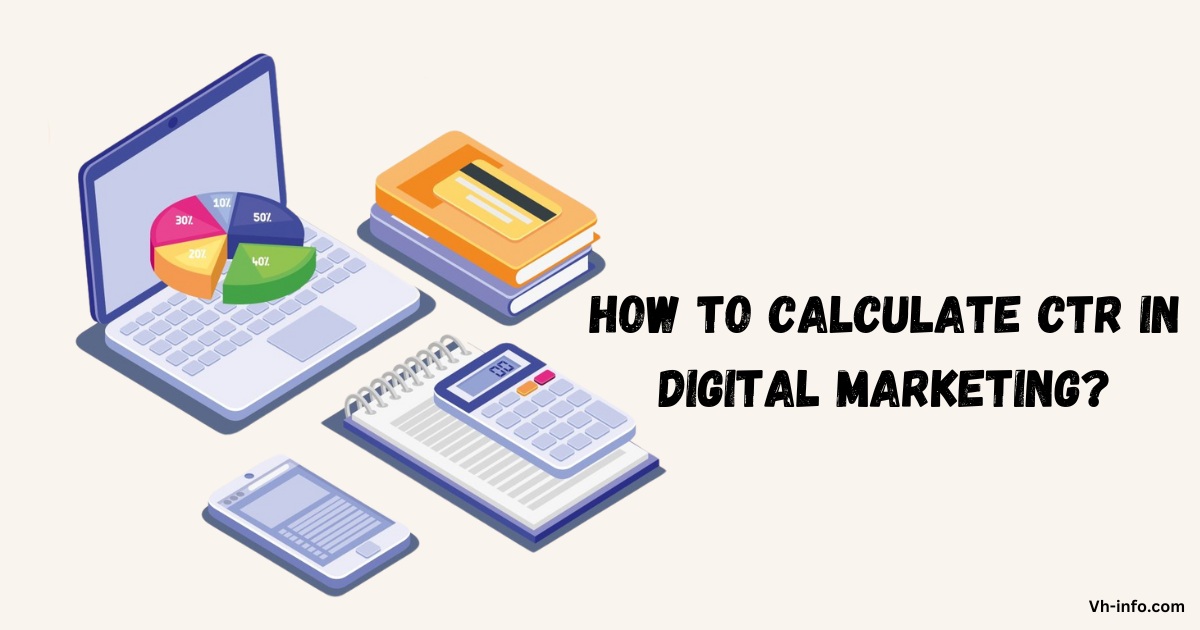Click-through rate (CTR) is one of the most important metrics in digital marketing. It measures how often people click on your ads, links, or call-to-actions compared to the total number of impressions.
CTR provides valuable insights into the effectiveness of your marketing campaigns, ad copy, targeting, and overall user experience.
As a SaaS company looking to build high-quality links and drive targeted traffic, understanding and optimizing CTR is important.
At VH-info, we specialize in helping brands improve their search rankings through proven link-building strategies. In this guide, we’ll break down everything you need to know about calculating, analyzing, and improving CTR for your digital marketing efforts.
What is Click-Through Rate (CTR)?

Click-through rate is the ratio of the number of clicks an ad or link receives divided by the total number of impressions, expressed as a percentage. In simpler terms, CTR measures how many people clicked on your ad or link out of the total number of people who saw it.
For example, if your Google Ads campaign generated 100 clicks from 1,000 impressions, your CTR would be 10% (100 clicks / 1,000 impressions x 100).
CTR is a key metric across various digital marketing channels, including:
- Paid search ads (Google Ads)
- Display advertising
- Social media ads (Facebook, Instagram, LinkedIn)
- Email marketing
- Organic search results
Importance of CTR in Digital Marketing

Click-through rate is an important indicator of the relevance, appeal and quality of your ads and content to your target audience.
A high CTR suggests that your marketing messages are resonating with users and driving engagement. Conversely, a low CTR may indicate issues with your targeting, ad copy, or landing page experience.
Here are some key reasons why CTR matters in digital marketing:
- Ad relevance: CTR is a direct reflection of how compelling and relevant your ads are to searchers. Higher CTRs signal to ad platforms like Google Ads that your ads are useful and should be shown more often.
- Quality Score: In paid search, your CTR directly impacts your Quality Score, a metric that influences your ad rankings and cost-per-click (CPC). Ads with higher CTRs and Quality Scores get better ad positions at lower costs.
- Campaign performance: Monitoring CTR allows you to gauge the overall effectiveness of your digital marketing campaigns. By comparing CTRs across different ads, keywords, and audiences, you can identify top-performers and areas for improvement.
- ROI: While CTR doesn’t measure conversions directly, it’s a leading indicator of campaign engagement and potential ROI. Ads with strong CTRs typically drive more qualified traffic and conversions.
- SEO impact: CTR is an important user interaction signal that can influence your organic search rankings. Pages with higher organic CTRs may be seen as more relevant by search engines like Google.
What’s a Good Click-Through Rate?
What constitutes a “good” CTR can vary widely depending on factors like industry, ad type, targeting, and placement.
However, here are some general CTR benchmarks across common digital marketing channels:
- Search ads: 2% is average, 4%+ is above average
- Display ads: 0.35% is average, 0.8%+ is above average
- Facebook Ads: 0.9% is average, 2%+ is above average
- Email marketing: 2.6% is average, 5%+ is above average
Keep in mind these are just rough guidelines. The best way to assess your CTR performance is to measure against your own historical benchmarks and continually work to improve.
Factors Affecting CTR
Many variables can impact your click-through rates in digital marketing.
Some key CTR factors to consider:
- Ad relevance to search query or audience
- Compelling ad copy and offers
- Eye-catching visuals and designs
- Prominent, actionable CTAs
- Audience targeting and segmentation
- Ad rank and positioning
- Brand recognition and trust
- Seasonality and timing
CTR Formula in Digital Marketing

How to Calculate Click-Through Rate (CTR)?
The standard formula for calculating CTR in digital marketing is:
CTR = (Total Clicks / Total Impressions) x 100
To calculate your CTR, simply divide the total number of clicks your ad or link received by the total number of impressions, then multiply by 100 to get a percentage.
Example Calculation
Let’s say your display ad generated 500 clicks from 100,000 impressions.
To calculate CTR:
CTR = (500 clicks / 100,000 impressions) x 100
= 0.005 x 100
= 0.5%
So in this example, your display ad’s CTR is 0.5%.
Tools For Measuring CTR
There are several tools and platforms available to help you track and measure CTR across your digital marketing campaigns.
Some popular options:
Google Ads

Google Ads provides detailed CTR data for your search, display, video and shopping campaigns. You can view CTR at the campaign, ad group, ad, and keyword level.
Facebook Ads Manager

Facebook’s Ads Manager platform shows you CTR data for your social media ad campaigns across Facebook, Instagram and Audience Network. You can break down CTR by ad set, ad creative, placement and more.
Analytics Platforms

Website analytics tools like Google Analytics allow you to measure CTR for on-site elements like banners, links and CTAs. For email marketing, your email service provider likely offers built-in CTR tracking and reporting.
Improving CTR in Digital Marketing

Optimizing CTR is an ongoing process that requires continuous testing, analysis and iteration.
Here are some proven strategies for improving click-through rates across your digital marketing campaigns:
Optimizing Ad Copy and Creative
Improving the relevance and persuasiveness of your ad copy, headlines, and visuals can have a big impact on CTR. Focus on highlighting unique benefits, using powerful action verbs, and aligning ad messaging with searcher intent.
Refining Audience Targeting
Ensuring your ads are being shown to the right audience is key for driving clicks. Use audience targeting options like demographics, interests, and behaviors to zero in on your ideal customers. Create tailored ad copy and offers for each audience segment.
A/B Testing Ads
Running A/B tests allows you to experiment with different ad variations to see what resonates best with your target audience. Test elements like headlines, descriptions, images, and CTAs, and allocate more budget to the winning versions. Always be testing!
Analyzing CTR Data to Inform Optimizations
Regularly monitoring and analyzing your CTR data can reveal valuable insights and opportunities. Use tools like Google Analytics and Google Ads to identify high and low-performing ads, keywords and placements. Look for patterns and apply learnings to continually refine your approach.
FAQ’s:
Is CTR Important For SEO & Digital Marketing?
Yes, CTR is an important user engagement signal for both paid and organic search. A high organic CTR can positively impact your search rankings, while a strong paid search CTR improves your Quality Scores and ad positions.
What’s The Difference Between CTR and Conversion Rate?
CTR measures the percentage of people who click on your ad or link, while conversion rate measures the percentage of clicks that result in a desired action like a purchase or signup. CTR indicates initial interest, while conversion rate reflects bottom-of-funnel performance.
Is There a Difference in Calculating CTR For Different Digital Marketing Channels?
The basic CTR formula of clicks / impressions is consistent across channels. However, the way impressions and clicks are counted can vary between platforms like Google Ads, Facebook Ads, and email marketing software.
Why is a High CTR Important in Digital Marketing?
A high CTR means more people are engaging with your ads and content, which typically leads to higher traffic, conversions and ROI. Strong CTRs also signal relevance and quality to ad platforms, boosting your ad rankings and lowering costs.
Is a High CTR Always Good?
Generally a high CTR is positive, but it’s important to also consider the quality of the clicks. If a high CTR is not translating into conversions, the traffic may not be relevant or your landing page may need improvement. It’s all about balancing quantity and quality.
Can CTR Be More Than 100%?
CTR is calculated by dividing the number of clicks by the number of impressions and multiplying the result by 100.
Therefore, even if all users who see an ad click on it, the CTR will still be 100%, as it represents a ratio rather than an absolute count.
However, if an ad or link generates more clicks than impressions in a given period it would likely indicate a tracking issue.
In general, CTRs higher than 10% are considered very strong for most digital marketing channels.
How Does CTR Impact Quality Score and Ad Rank?
Click-through rate is a major component of Quality Score in Google Ads. Ads with higher CTRs are seen as more relevant, which raises your Quality Score. A high Quality Score can in turn improve your ad rankings and lower your cost per click.
What’s a Good CTR For Display Ads Vs Search Ads?
Display ads typically have much lower CTRs than search ads, since they are not based on user search queries. Average CTR for display ads is around 0.35%, while search ads average 2% or higher. So a “good” CTR is relative to the ad type and industry benchmarks.
How Often Should I Review and Optimize For CTR?
We recommend monitoring core CTR metrics weekly or biweekly to spot issues or opportunities. In terms of A/B testing and optimization, run tests for at least 2-4 weeks to gather sufficient data. Prioritize high-impact elements like headlines and images for more frequent testing.
What Are The Common Mistakes To Avoid When Analyzing CTR Data?
One pitfall is making decisions based on too small of a data sample. Make sure to collect enough clicks and impressions to draw reliable conclusions. Another mistake is focusing solely on CTR without considering conversion rates and overall ROI. Always analyze CTR in the context of other key performance metrics.
How Does CTR Impact Overall Campaign Performance And ROI?
CTR is a key leading indicator of campaign engagement and profitability. Ads with high CTRs tend to drive more qualified traffic, leading to higher conversion rates and return on ad spend. Improving CTR can have a positive ripple effect across your digital marketing funnel.
Are There Any Tools Available To Help Track And Analyze CTR Effectively In Digital Marketing?
Yes, most major digital ad platforms like Google Ads and Facebook Ads have built-in reporting on CTR. Website analytics tools like Google Analytics can also measure on-page CTRs. For more advanced analysis, consider using a dedicated PPC reporting tool that can aggregate data across multiple channels.
Is CTR Important For SEO?
While not a direct ranking factor, CTR does impact SEO indirectly. Search engines like Google use CTR as a user engagement signal – pages with high organic CTRs are seen as more relevant keywords and may be rewarded with better rankings over time.
This is important for digital marketers to understand, as optimizing their title tags and meta descriptions for clicks can support their overall SEO and online marketing strategies and efforts.
Conclusion
Click-through rate is a fundamental metric for measuring the success of your digital marketing campaigns.
Understanding how to calculate, analyze, and enhance CTR can help you increase active traffic, minimize ad spend wastage, and ultimately enhance your marketing ROI.
At VH-info, we’re committed to helping brands master the art and science of digital marketing through our expert link building services and educational content. To learn more about how we can elevate your search rankings and online visibility, check out our SaaS link building solutions or contact our team today.

